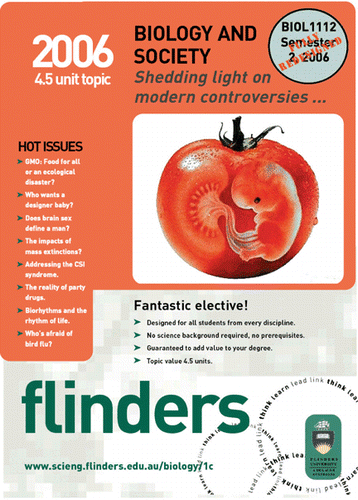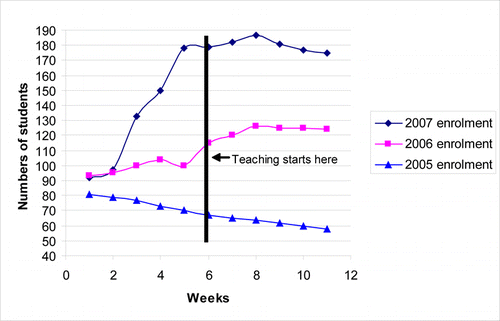Introduction
Science Education can be split into two categories: one to provide the basic concepts, knowledge and techniques that students need to follow careers as scientists and the other to provide scientific literacy that will enable students who do not necessarily desire careers in science to be able to understand the world around them. Clearly, courses that aim to provide information for science graduates may not be relevant or of interest to students not planning to become scientists. However, courses that aim to improve scientific literacy would be of value to both groups. Scientific literacy in Europe and the USA is known to be poor (CitationNational Science Foundation, Science and Engineering Indicators, 2002; Eurobarometer 55.2, Europeans, science and technology, 2001), and although tackled at the high school level may need to be implemented again at the tertiary level in order to have the effect required (CitationNorris and Phillips, 2002).
In a society where science and technology are moving at an ever increasing pace, it is essential for people to have at least a basic level of scientific literacy in order to understand the world around them. This knowledge will enable people to make informed choices about their health care, their environment and the society in which they live. It will also give them the ability to critically analyse the validity of a given argument or media presentation in order to come to a logical conclusion based on knowledge rather than on propaganda or hype. University students (both national and international) are our future and our potential leaders so it is particularly important for them to be able to weigh up ethical, moral, and social impacts while maximizing the benefits of a given scientific development. Yet the proportion of students who study science at the university level, is at an alarmingly low level, and continues to decrease. In fact between 1994 and 2004, there has been a 20% decline in student enrolments in tertiary science courses in Australian universities (CitationKrause et al. 2005).
In Australia and the UK, where undergraduate degrees take 3 instead of 4 years to complete, and where most degree programs are very finely structured, unlike the liberal arts or sciences degrees in the USA, very little room exists for electives. Science courses at university have a reputation for being difficult, requiring a great deal of background knowledge and being perceived as being rather boring in content. Consequently, students stuck in a highly prescribed degree program are unlikely to take a science course when they have very few elective slots. Therefore, to improve scientific literacy amongst our university graduates, science courses need to be promoted and taught in a way very different from their current form. Science is incredibly exciting and very visible throughout the media, therefore, it has the potential to draw in large numbers of students if properly advertised, taught and promoted by the university or faculty teaching it.
Helping students to become interested in, and understand the world around them, to engage in discussion about science, to be sceptical and make evidence-based conclusions, as well as to make informed choices about the environment and their own health should be of upmost importance and considered as a requirement for all students within the university system.
Methods
To ascertain the likelihood that students would enrol in a science elective course and to determine whether it is possible to affect scientific literacy, I developed a course at Flinders University specifically to introduce scientific concepts to students through issue-based teaching. The course was intended to engage both science and non-science students through the presentation of topical science issues by experts in the field. In addition, the assessment component of the course was designed to ensure that students learn to communicate both their depth of understanding and an argued opinion thereby gaining scientific literacy.
Approximately 300 flyers (see ) aimed at attracting students were placed strategically at enrolment centres and handed out at information sessions. Interesting the flyer was fairly successful in attracting students as 44% responded that they enrolled in the course because they had seen the brochure. They commented that the course sounded interesting, fun and was a good starting point. Of the students that did enrol over 50% were non-science students, 22% of which had no previous experience with biology beyond year 10 level.
Student attendance at lectures in this course was much higher than in the core biology course at 85% compared to 60%. Did it change their minds about science?
82% of students said that because of this course they wanted to take a second semester course called Science and Society
58 % of the students who were not enrolled in the core Biology course went on to enrol in the second semester core Biology course after taking Biology and Society.
The demonstrated outcomes and impacts of this innovation clearly indicate that this approach has made significant inroads to bridging the gulf that has long existed between science and non-science students. The newly developed course ‘Biology and Society’ replaced a more traditional style course that consisted primarily of a lecture series based on the biochemistry of life that was poorly received by students and resulted in a low number of student enrolments (on average 50 students per semester). In 2006, the course was fully redesigned and enrolment numbers indicate the change in student interest and response to the course (see ). Biology and Society from 2006 onward was designed to incorporate the following features:
weekly themes covering the science behind local and global issues of prominence, such as HIV-Aids, climate change, party drugs, loss of biodiversity, bioterrorism, fad diets, how to define humans, ethics, (see Appendix 1 for lecture titles)
use of prominent local scientists and community leaders
use of clever technology, such as personal response units (’clickers’)
a focus on the importance of critically analysing and communicating ideas in both verbal and written form
independent thinking and understanding rather than rote learningo
no exam, focus on written critiques
Figure 2 shows the change in enrolment and retention once the course was changed to emphasis current issues and scientific literacy.
Student comments such as the following highlight the impact the course has had on students:
“Engaging and controversial topics. Interesting, informative, with lively discussions.”
“It’s unique! No other courses are presented like this one, which made it interesting due to its broad scope.”
“Relevant issues, very up-to-date information and first hand from lecturers directly involved in research.”
“I liked how each week there was a different theme to be covered which kept me interested and intrigued.”
“I found the course without question the most stimulating course on campus.”
“I have found that I have improved greatly with my critical thinking and writing skills.”
“I absolutely loved the issues brought forward and further enjoyed the research I did on the topics.”
“It was my must fun and challenging subject. Cheers!”
“Thoroughly enjoyable, interactive experience. Should be regarded as core to any biologist/human being.”
“Was a fantastic subject, one that I would take again. It has helped me decide my future path.”
“All students should take up this course.”
“Very enjoyable and at times, very confronting and mentally challenging way of thinking about things.”
“This was a great course, the best I have taken at uni so far.”
Appendix 1
A short history of the world
Evolution vs. Intelligent Design
What is DNA?
What defines a human?
Frankenfish
Party Drugs
Drug Labs
What the body needs (nutrition and physiology)
Fad diets
Performance Enhancing Drugs
Fossils and climate change/human impact
Loss of Biodiversity
Stem Cells/Cloning
Bioethics
Forensics
Legal and political implications of environmental issues
Genetic counselling/eugenics
Evolutionary genetics
Fish Kills — are we to blame?
Where there’s mud there’s money
Sexually transmitted diseases
Ethics in drug supply for HIV and malaria
Preparing for an influenza pandemic
What is the difference between males and females?
Sexual selection in humans
’Finding Nemo’ — protandrous hermaphrodites: the realities of clownfish behaviour
Who’s afraid of the bird flu?
Global warming and food production; will there be enough food for all?
The biology of Wine Making
Ancient DNA
Zoo ethics and Conservation
References
- Eurobarometer 55.2, Europeans, science and technology, 2001. http://europa.eu.int/comm/research/press/2001/pr0612en-report.pdf, Accessed March 25, 2008
- KrauseK., HartleyR., JamesR. and McInnisG (2005). The First Year Experience in Australian Universities: Findings from a Decade of National Studies http://www.dest.gov.au/NR/rdonlyres/1B0F1A03-E7BC-4BE4-B45C-735F95BC67CB/5885/FYEFinalReportforWebsiteMay06.pdf, Accessed March 20, 2008
- National Science Foundation, Science and Engineering Indicators, 2002, http://www.cnc.ac.cn/gb/others/nsf/200201/home.htm. Accessed April 10, 2008
- NorrisS.P. and PhillipsL.M. (2002) How literacy in its fundamental sense is central to scientific literacy. Science Education 87(2), 224-240

